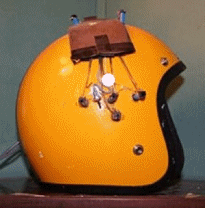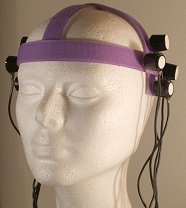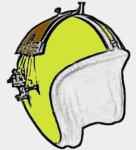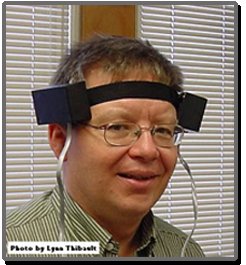
Thanks are due to the late Dr. Michael Persinger for his extensive help.
Persinger’s Endorsement.
The God Helmet ®, part of the Shiva Neural Stimulation System.
Phone:(855) 408-7888
THE GOD HELMET WARS – An Overview of Some Flawed Criticisms.

The God (“Koren”) Helmet experiments, carried out at Laurentian university in Sudbury, Ontario, are famous for inducing religious and mystic experiences in the laboratory. These have included out of body experiences, visions of angels, and other “spirit beings”. There is also a case where the God/Koren Helmet recreated a ghostly episode. A small percent of the subjects even had visions of god.
This article will tell the story of how a few skeptics worked to falsely discredit the work of Dr. Michael A. Persinger (who designed the Helmet – sometimes called the “Koren” helmet, after the man who built it.) through a series of poorly-done research studies, guided by an antagonism towards religion and spirituality. Dr. Persinger’s experiments showed that religious and mystic experiences appear as a result of the brain’s internal design; its architecture and organization. This means that spirituality is an intrinsic part of the human species and that some people, with sufficiently flexible brains, so to speak, will inevitably have otherworldly experiences, at least once in awhile. It’s part of their mental makeup, or neural profile. And this kind of people, about 20% of the population, are a part of our population. This line of reasoning helps us see that spirituality is an intrinsic part of human culture, and may have helped us survive in our early evolutionary history.
Another view which we see in many scientists is that religion is utterly worthless, and that religious faith and belief are nothing more than delusions, while religious experiences are symptoms of psychiatric disorders. Richard Dawkins, the author of “The God Delusion” is one of the main proponents of this view. Under the slogan “imagine no religion”, Richard Dawkins’ many supporters have actually called for it’s abolition, even though they know such a program has no chance of success. However this extreme view lets us see why so many scientists have worked to falsely discredit Dr. Persinger and his experiments, so that Dr. Persinger’s ideas about spirituality and religion receive very little attention.
If Dawkins’ is right, then the abolition of religion would be a tremendous blessing to all of humanity, and usher in a shining era of rationality, good government, and finally, world peace. If Persinger is right, then the abolition of religion would be an atrocity, and would attempt to prohibit a class of behavior that’s intrinsic to the human species, though not equally in all people. Religion is a part of who we are, all of us together, but not a responsibility for each individual person.
Some of us carry our religions lightly, as comfort, a source of guidance, or day to day inspiration. Some of us immerse ourselves in the pursuit and culture of mysticism, psychic perception, and focus on sacred themes in their daily lives. And some of us just aren’t interested in religion or spirituality. That’s the way it’s supposed to be; a “spread” of interest in religion. That’s the way our species has been designed by the benign hand of evolution, which (ruthlessly) pushes us always towards survival. And religion is one of the ways we avoid going extinct. It binds our cultures and peoples together, allowing groups of people to act as one, comforts individuals in time of stress or grief, and helps keep our conflicts to a minimum.
Dr. Michael Persinger’s experiments pointed to the possibility that the experience of god is a normal brain response to certain, stressful, events.
People who believe that religious experiences are delusional are bound to be offended by this idea. Delusions are rarely helpful, and the people that have them are usually thought to be poor contributors to their societies.
Over the last 20 years, a handful of scientists, most of them students, have performed experiments to try and discredit the Persinger’s technology. Along the way, skeptical editors on Wikipedia have worked hard to ensure that its pages for the God (Koren) Helmet and Michael Persinger maintain a hostile tone.
Let’s look at these experiments and some of the commentary, which has taken an important technology, developed any university laboratory, reported on by many journalists (many of whom experienced the God/Koren Helmet firsthand), generated dozens of peer-reviewed scientific articles, and try to discredit it, without any of them ever actually using it correctly (or using it at all) or understanding the principles that led to its design.
Dr. Michael Persinger appeared in many television documentaries, giving him the kind of fame that neuroscientists rarely receive. Standing head and shoulders above the crowd, he was not only an easy target to aim at, but also one that many people would like to simply “take down”. As we shall see, some of the studies border on dishonesty, and in one case, one of the students involved in the effort to discredit the God/Koren Helmet actually went so far as to fake their data, a cardinal sin among scientists.

Michael Shermer in Persinger’s lab, shortly before his Out-of-body Experience and feeling of a presence.
THE SWEDISH STUDY (2004)
In the year 2000, a group of students from Sweden approached Dr. Persinger, and asked him to provide hardware and software that would allow them to repeat his stimulation protocols so that they could observe the effects through PET scans. Doctor Persinger agreed, and his research group’s technician, Stanley Koren, built the equipment and gave them a copy of his software (an 8-bit DOS program called “Complex). By today’s standards, the software was kind of “clunky”, but back in those days, there were very few laboratory softwares that would look user friendly now.
Dr. Persinger also provided instructions for how to use the equipment to conduct their experiment. He had found that the effects of his magnetic stimulation appeared on EEG after about 10 minutes of stimulation. However, it took 5 to 10 minutes longer for the subject begin to feel the effects directly. When they returned to Sweden and began their work, they apparently didn’t remember, or didn’t know, that the Helmet’s subjective effects take longer to appear.
They also decided that they would break their promise to do PET scans on the subjects. Instead, they decided that they would move immediately to a more advanced procedure, the “sensed presence” protocol, the one that had elicited the feeling that there was a nonphysical being nearby, as when people feel there’s someone standing nearby them, but when they turn to look, they find that no one is there. This procedure requires two phases, applying to different magnetic signals. Each one of them is applied for a minimum of 15 minutes, so that the whole stimulation session lasts 30 to 40 minutes. The effects simply won’t appear when it’s applied for only 10 minutes.
More importantly, the Swedish researchers did not follow the instructions for setting up the software. They were supposed to run it on a slow 286 computer. They did not. Instead, they ran the software on a much faster 386 computer, and instead of running it under DOS (it was written for DOS), they ran the signals under Windows. Stan Koren’s signal generator connected to the computer through the printer port, and windows had a different way of handling output from the computer to the printer port. The result was that the signals were 1) distorted and 2) run too fast, and could not possibly have the effects that Dr. Persinger had seen in his laboratory.
They also claimed that the low-intensity magnetic fields weren’t strong enough to have any effect on the brain, in spite of many studies that reported neural effects from weaker fields. They also claimed that Persinger’s fields couldn’t reach into the brain, ignoring the laws of physics, which tell us that nothing can block or stop a magnetic field.
There are other problems with this study, but these were the most important.
Naturally, the Swedish Group had no results, but instead of contacting Dr. Persinger to get some tech support for their equipment, they decided that the reason that they were having no effects was because there were no effects to be had. They seem to have decided that, because they had failed with their equipment, Dr. Persinger’s results were because Persinger had made mistakes. They speculated that the God/Koren Helmet was a placebo and that Persinger’s subjects were responding because they knew what the experiment was about (in fact, they had been told that they were participating in a “relaxation experiment”), and that the subjects were especially suggestible (though they did not test for suggestibility). It’s a poor workman who blames their tools, and the workman who blames the man who made the tools is even worse.
The Swedish Group published their results in 2004, and soon after, it became a media story, and there were several debate papers (example) published by Dr. Persinger and his Swedish colleagues, no longer friendly visitors to the lab, but now as academic adversaries. The Swedish group’s publication claimed the subjects who had the most to report from their time in darkness and isolation were also the most suggestible (even though they didn’t make any attempt to measure suggestibility). However, when Dr. Persinger compared data from his control groups to the data published by the Swedish group, he found that they were very close to each other. After delivering an incorrect stimulation, the Swede’s results were the same as Dr. Persinger’s results from his control group, who received no stimulation at all.
Ultimately, this study, with all its errors, set the tone for a new view of Dr. Persinger’s work which, as we will see, culminated in hostility towards the God/Koren Helmet on Wikipedia, one of the largest sources of information on the internet.

The God/Koren Helmet works best with a blindfold and silence.
The “Haunted Room” project.
The Haunted Room project was the brainchild of a British researcher named Christopher French. He had a long history of debunking paranormal claims, including those of ghosts, apparitions, and “haunted houses”.
Although few of Dr. Persinger’s papers addressed “paranormal” activity specifically, he was featured on a number of television documentaries on ghosts, hauntings, visitors from beyond the grave and other, similar, themes. He was able to explain that most demonic visions originate from within the brains of those who see them, and are not actually visitors from other worlds, other dimensions, or the land of the dead. He had used the Koren Helmet to recreate a “haunt” experience for a visitor to his lab who had been through such an experience some years earlier.
Dr. French decided to add two kinds of stimulation to his experimental chamber and create a synthetic or artificial haunted location. One of them was ultrasound, and the other was stimulation with magnetic fields bearing a signal that he derived (incorrectly) from one of Dr. Persinger’s papers. He applied the stimulation to a room, and placed his subjects inside it. He did not succeed in creating any paranormal experiences. One of Dr. Persinger’s student’s had tried the same thing previously – applying one of the signals, not to one or both sides of the brain, but instead, to the whole body. It didn’t elicit any effects in Dr. Persinger’s laboratory, which wasn’t an unexpected result. The God/Koren Helmet’s most effective session stimulated, one side of the brain with one signal first, and then both sides of the brain with another signal. Besides that, the signals are only applied to the temporal lobes of the brain; the area above the ears. When the same stimulation is applied to the whole body, all areas of the brain are stimulated at the same time, and the stimulation won’t have any effect. French’s paper did say that his results were inconclusive and that more research was required. As it happens, French’s method for deriving the signals and turning them into a sound file using ordinary audio editing software also simply could not work. The audio files that do duplicate the Persinger’s signals were developed on a pixel–by–pixel basis. Not only could Dr. French’s attempts at creating effects by stimulating the whole body never have succeeded, but the signals he used in his experiment were also doomed to failure.
This study has also found its way into the Wikipedia page for the Helmet, even though Dr. French never even claimed that his procedure had anything to do with the actual God Helmet.

The 8 Coil Shakti.
“Can The 8 Coil Shakti Alter Subjective Emotional Experience?”
The Eight Coil Shakti is a neural stimulation system that uses magnetic signals which Dr. Persinger also used in his work. Even though it’s not the Koren Helmet, they do have some similarities.
This study was carried out by a student (and their professor, Mat Gendle) at Elon University, and published in 2012. It consisted of showing some subjects emotionally powerful images (from the international affective picture system) before and after they received a session with the 8 Coil Shakti. The Shakti system has a session for mood enhancement called the “feelgood” session.
It’s designed to improve overall mood for some people (especially those who feel that their worst in the morning). It takes six sessions, once a week, to do its work. Nevertheless, basing their experiment on a speculation that it would achieve instant effects, they measured differences, not in their subject’s moods, but rather how they responded to a set of photographs. Naturally, they didn’t see any difference in the way their subjects responded to the pictures. They were looking for an effect that might take weeks to appear after just a few minutes. They also made no attempt to separate their subjects into those were prone to respond (people who feel at their worst in the morning), and those who weren’t.
Besides that, this study applied the signals over the temporal lobes (above the ears), while the software page for the mood enhancement session clearly showed that the magnetic coils needed to be applied over the frontal lobes (above the eyes). To put it simply, both temporal lobes are the wrong places to put the magnetic coils to try to elicit emotional effects most effectively.
Dr. Gendle didn’t use all of the pictures in the international affective pictures system. The ones he did use were also used in a previous study, carried out in Italy. That experiment was done to try to see some of the effects that long-term stimulation with quiet magnetic fields, such as we find around the earth itself, might have any effect on astronaut’s health. They showed their subjects the same set of pictures Gendle used during stimulation with magnetic fields, but they measured three more things. The first was skin conductance. The second was blood pressure. The third was heart rate.
This study found that the magnetic fields had no effect on the subject’s blood pressure, heart rate or their response to the images. However, skin conductance was significantly higher for those receiving the magnetic fields while they looked at the “emotionally involving” pictures. The magnetic fields did have an effect, but you had to look at both skin conductance, and emotional response to the pictures to see it. Gendle didn’t do that measure, even though he had already seen a study where responses to emotional images didn’t change with magnetic field stimulation. How do we know Gendle had seen the Italian space medicine study? It was one of his references. It almost seems like he wanted to avoid any response to the fields. Gendle, citing the Swedish researcher’s (speculation) that Dr. Persinger’s effects were due to placebo effect and suggestibility in the subjects, offered his conclusion that the many effects reported from the Shakti magnetic stimulation system were also due to the same things. His conclusion looks like speculation built on guesswork, took no cognizance of how his experimental procedures were not an effective test.
As one might expect, this study is referenced on the Wikipedia page for the God (Koren) Helmet, even though it’s about a different technology.
This same researcher had previously done a study about the energy drink Red Bull. He gave half of his subjects fake red bull, essentially sugar water with a bit of flavoring in it, and the other half were given real red bull. He told all of his subjects that it was an energy drink, and that they might find themselves a bit over stimulated. When some of his to control subjects (given sugar water) reported that they felt over-stimulated, Dr. Gendle concluded that the effects of Red Bull were “all in your head”. However, the conclusion implies that B vitamins and caffeine (major components of red bull) work through placebo effect. Ask any cardiologist if caffeine has an effect on emotions and energy levels, and they will tell you: yes, it does. They’ll also add that some people should stay away from caffeine because it can be dangerous for them. Some researchers have a taste for “debunking” and “take down” research and experiments, and Dr. Gendle may be one of them.
The next experiment we’ll look at did not use any stimulation at all, so it was not possible for the graduate student who conducted it to compare to subjects and controls. An experiment that has no control group can still be quite valid, if the results are compared to normative data, or measurements taken before the experimental procedure is performed. For example, you could take the blood pressure of a group of athletes, and have them run a mile. Then, you could measure their blood pressure again. The measurement before they began running is the control condition, and the measurement taken after their run can be the “stimulus” condition. There can be no “placebo” version of a hundred yard dash. Controls are not absolutely essential in all kinds of research. There are several kinds of controls, and placebos are only one of them. But what can we say about an experiment that didn’t use any stimulation? That only used placebo subjects? That’s what we find in the next experiment we’ll look at here.

The God/Koren Helmet is not a placebo.
A “Placebo” God Helmet Experiment.
In August of 2016 Dutch undergraduate David Maij and some colleagues did a strange study carried out, not in a laboratory, but during a Dutch music festival. They invited people attending the festival to undergo a placebo procedure using a helmet wired up to look as though it could deliver actual brain stimulation. In fact it was a “dummy” device that didn’t do anything. Possibly to take advantage of Persinger’s helmet’s reputation for delivering stimulation culminating in religious and mystic experiences, they named it after Persinger’s technology.
They advertised their activity in the festival’s booklet, saying: “Tripping with the God Helmet: researchers of the University of Amsterdam will electromagnetically stimulate your brain to elicit spiritual experiences.”
In fact, their helmet didn’t do anything. It was a fake from the beginning. The subjects wearing their helmet listened to stereo headphones playing white noise, but received no electromagnetic or magnetic stimulation of any kind. One group of subjects was told that the helmet was switched on, and another was told that the helmet was turned off. Not surprisingly, the group that was told that the helmet was on reported more effects than the group that was told the helmet was turned off. If you tell a group of people that you are going to give them a mildly hallucinogenic pill, but actually give them sugar tablets, some of them will report more than just nothing. The results here are much more about the placebo effect than the Persinger’s apparatus. You can’t elicit a placebo effect if you don’t tell the patient exactly what the sugar pill is supposed to do.
Maij’s results included a small percent of people who reported spiritual effects, as we might expect. However, when we compare his results to what Dr. Persinger saw in his control subjects, we find that they are almost a perfect match. Dr. Persinger did not use “placebo” stimulation in his studies. Rather, he used “control” subjects, who wore the helmet in the silent experimental chamber, after being told they were participating in a “relaxation experiment”, but received no actual stimulation (the helmet was switched off). The difference is important. The placebo affect relies on telling the subjects or the patient what a medication or stimulation will do. You can only get a placebo effect from fake aspirin if you tell the patient that it will, for example, cure their headache. There’s no reason to think that a sugar pill has any chance of initiating a placebo effect if you don’t tell them it will help their headache, or just give them misleading instructions. In Dr. Persinger’s experiments, all subjects (both stimulation and control) were told that they were participating in a relaxation experiment, ruling out “placebo” effects.
In Persinger’s experiments, 10% of the subjects experienced the sense of a presence in control conditions. In the Dutch music festival experiment, about 5 ½% had the same experience. Dr. Persinger’s experiments were conducted in a soundproof chamber, so that subjects, instead of hearing white noise or some kind of distracting sound, actually sat in total, acoustic, silence.
In sharp contrast, with the actual God/Koren Helmet stimulation, wearing a blindfold in the ultra silent chamber, 80% of Dr. Persinger’s stimulation group subjects felt a presence in the room with them.
In fact, even though they claimed that all the effects they noticed were from their “fake” Helmet, the Dutch researchers used white noise to mask background sounds. As it turns out, white noise is a mild hallucinogenic agent, and two studies have been published showing that white noise alone is enough to get people to believe they’re hearing sounds that actually aren’t there.
In spite of the fact that the Dutch music festival “”Fake Helmet” had such a low incidence of sensed presence experiences, the Dutch researchers seemed to feel that their very small number was quite significant. But that’s what can happen when to control conditions are not compared to stimulation conditions. Ostensibly, the objective of the Dutch study was to see how much alcohol would affect experiences driven only by expectancy. In this case, expecting to have a spiritual experience because a brochure said you would. Soon after this study was published several websites wrote up the story, including Newsweek magazine. They all announced the same thing: that fake brain stimulation could do the same thing as the real thing, even though none of them compared the Dutch data to the results from Persinger’s actual laboratory experiment’s.
As it turned out, participants in a very similar “fake” magnetic Helmet study simply did not believe the cover story for the experiment. When this became apparent, one of the faculty decided to go back and look at the raw data for the first (music festival) experiment. He published an article in a scientific journal saying that almost all of the logs for that study had been entered on the same date. He confronted the student, who had no explanation, and was angry at being accused of fraud. The result was clear. The data from the first study had been faked. The student didn’t want to make the effort to do the actual testing, so he entered the data himself – multiple times. “To please his superior he even faked the psychophysical data in a direction that was compatible with the hypothesis”. The student was banned from the university.
As a result of these studies, none of which were properly carried out, and one of them tainted by data fakery, the scientific community has largely turned away from Dr. Michael Persinger’s work, and very few of them appear to be interested in digging deep enough into the actual evidence. What’s at stake is not whether or not Persinger’s work is valid, but rather which paradigm about the nature of spirituality offers the best foundation. Dr. Persinger’s ideas are not popular with those who believe that spirituality and religion are essentially delusional. And they dominate many wikipedia pages.
WIKIPEDIA
Wikipedia is the 3rd largest source for information online, and often ranks at the very top of the Google results when a Google search matches the name of one its pages. Its huge influence makes it attractive for editors with an ax to grind. The Koren Helmet is no exception. One of the main editors for the God Helmet page who called it “stupid … twattle”, abandoning all pretense of unbiased reporting, has made over 100 edits to the page.
Another, no longer a valid user name (“goblinface”) was banned for creating multiple identities.
He used them to make hostile edits on several pages.
This includes the page for Dr. Persinger.
Brute-force editing and forceful debate on Wikipedia’s “talk” pages can set the tone for Wikipedia’s content, and that can help to suppress some points of view in the sciences.

The God/Koren Helmet has been used in
ways few people are aware of.
Other work by Dr. Michael A. Persinger.
In his long career as a scientist, Dr. Persinger published over 500 scientific journal publications, the overwhelming majority of which were peer reviewed. However, because he became well known for inducing spiritual experiences in the lab, and because the God Helmet has been subject to a “smear campaign”, though perhaps without a commander, his work in other areas has been neglected and overlooked.
Perhaps the most significant of these is his (circumcerebral – around the head) “octopus” apparatus. This is a device that has succeeded in eliciting enhancements in remote viewing as well as measurable direct brain–to-brain (telepathic) communication.
The most tragic loss in the campaign to falsely discredit Dr. Persinger is his work on depression. He published several experiments (sample) in which he was able to achieve strong reductions in depression using the same kind of low-intensity magnetic signals used in the God/Koren Helmet experiments.
Another line of research has been on the personalities of people with very responsive (labile) temporal lobes, including spiritually-inclined people, creative workers, and people with temporal lobe epilepsy.
Dr. Persinger’s work is a treasure trove of work covering many aspects of human psychology, and it’s neglect would be an irreparable loss to human psychology and even to humanity itself.
The meeting of science and spirituality in Persinger’s work allows the possibility that spiritual practices, such as yoga and meditation, may one day be taught in science classes, allowing them to break out of the shell of traditional religious beliefs, and enter our cultures, societies and homes, without carrying the baggage of old and now-rejected medieval dogmas.
In closing, I should mention that the flawed experiments we’ve looked at here were all student projects, with the experimenters doing their very first brain stimulation work. None of them were carried out by anyone with experience, and none of them used any kind of brain imaging, like EEG, PET, or LORETA.
♦♦♦
The Shiva Neural Stimulation System is
$649.00 Plus Shipping
(Shipping – $20.00 in the USA & $40.00 for all other countries)
ORDER THE SHIVA SYSTEM
INCLUDING THE GOD HELMET HARDWARE AND SOFTWARE
NOTE: The God Helmet is one of the Configurations for The Shiva Neural Stimulation System.
Contact us.
In the USA and Canada, you can order by calling 24/7 (Toll-Free)
(855) 408-7888
Read the Terms and Conditions before you call.
Legal: God Helmet Stimulation signals are based on the God Helmet signal templates licensed by Stan Koren and Dr. Michael A. Persinger.
The Shiva System and (it’s sibling technology), the God Helmet does not prevent, diagnose or treat any medical disorders.
The God Helmet Experiments (Book)
________
Gaia.com article on the God Helmet.
________
Review article by Dr. Michael Persinger:
Experimental simulation of the God Experience using the God Helmet
________
THE GOD HELMET is a trademark (serial number of 90072427).
.
.
.